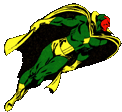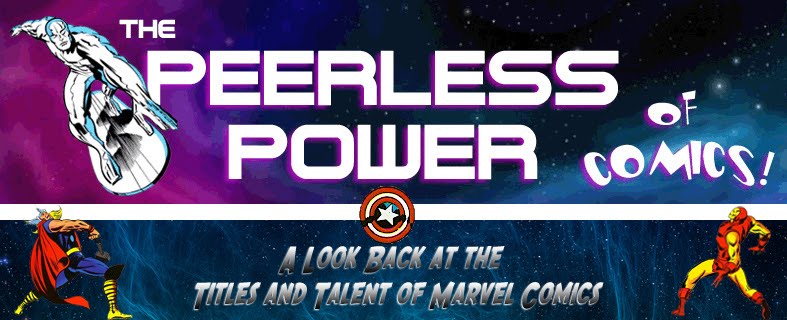"On occasion, my duties include examination of the histories of alternate universes.
"I have shown you a portion of the events which occurred in one such reality, in which the star-spanning Kree Empire emerged victorious from a galactic war. But that was only the first half of the answer to the question: What If... The Avengers Lost Operation: Galactic Storm?
"This is Part Two."
-- The Watcher, who insisted on offering the PPC's recap to Part One of this story. (Like I had a choice of refusing a being who can traverse entire universes at will.)
To expand on the Watcher's summary a bit: A year and a half following the Operation: Galactic Storm crossover event, writer Len Kaminski crafted a much different outcome of the Kree-Shi'ar War--and a more grim one for the human race, in which the Earth was destroyed by the Kree and the Avengers (at least those who survived the Kree's retribution) became fugitives mounting a resistance movement with the goal of bringing down the Kree Empire.
CAUTION: Assuming you're a Gladiator fan and are even now putting in an online order for this story on that basis, you should know that Gladiator's presence on the cover of issue #56 is a tad misleading (sarcasm implied), considering that the character does not make an appearance in this story in any capacity. You might rightly think that he would, given that the Kree also destroyed Chandilar (the Shi'ar throneworld) on the heels of destroying Earth--and if there's a member of the Imperial Guard who would charge in to exact vengeance against the Kree, it would be Gladiator. Alas, we're left to assume instead that Gladiator was present on Chandilar at the time of its destruction by the Kree Omni-Wave device.
"whispermumblemumble..."
What's that, Watcher?
"mumblewhispermumblemumble..."
Yes, good point. Moving on, the Watcher wishes to elaborate on his opening by offering a two-page digest describing the dire straits that have befallen countless other worlds in the years that have passed since the Avengers and the Guard (along with members of the Kree Underground Resistance) began working toward the defeat of the Kree. It seems they have a long way to go, against an intractable enemy that is obsessed with its own mission: to pursue an insane agenda of star-spanning genocide.
After which Kaminski takes the reins of the story, attaching an addendum to the Watcher's presentation which lets us know the dismal state of Kree society due to the diversion of resources to the military--and that, as a result, not all the Kree are aligned with the propaganda rallies of Ael-Dan, who has become even more of a dictator over the years.
Since Part 2 will wind up this story, Kaminski immediately moves to the execution of a plan by Cap's forces which will hopefully turn the situation around for them--though whether it will succeed is admittedly a gamble, depending as it does on not only penetrating one of the most secure installations of the Kree homeworld but also on the actions of the entity that is the target of their raid.
And that scheme is put in motion on a remote Kree moon, which is where the Kree maintain one of their intergalactic communications nodes, as well as an archive of sensitive data which will facilitate the Avengers' plan. But the offensive is not without cost. After the raiding party is discovered by a contingent of Kree soldiers, the ensuing battle mortally wounds the Black Knight and compels one of the Guard, Smasher, to remain behind to cover their ship's escape. And there is another complication which may render the entire mission moot.
Unfortunately, the news is grim upon the strike team's return to base. We come to learn that the mission has been a success--though given the sacrifices which were made to ensure it, few if any are willing to use that word to describe its outcome.
As the casualties grow, it's helpful to recognize the fact that we are, after all, reading a What If story, a book which in many cases takes a premise and shapes the story to deliver a number of shocks which inevitably lead its characters to suffering a tragic fate as opposed to their mainstream counterparts. And while it's true that the heavy losses we've seen thus far fall squarely into that format, it seems appropriate to give credit where credit is due and recognize the element that has made this tale somewhat easier to swallow than the others: the Kree military, which knows its business and excels in crushing resistance while dealing fatally with its enemies.
In Kaminsky's portrayal of the Kree at war, for instance, we watched as the Omni-Wave projector was liberally used in its capacity as a weapon, to devastating effect--and, afterward, the Kree moved post-war to cement its grip as a galactic empire while sweeping other star systems in a campaign of slaughter. In Roy Thomas's Kree-Skrull War from 1972, the Avengers (along with the Earth, barely) were mostly spared having to face the engagements, repercussions, and consequences of true warfare from hostile galactic empires (empires, mind you) armed to the teeth with forces who wipe out their enemies as a matter of course and regard the Earth as little more than a tactical blip. The team was virtually in and out of that conflict, essentially none the worse for wear upon their near-instant return courtesy of the Kree Supreme Intelligence--whereas in this tale it's taken Cap and his team years to get to the point where they can attempt to avenge the destruction of the human race and hopefully prevent other worlds from suffering the same fate.
And speaking of which: What does that plan entail? Mostly, the goal is to bring down the Kree government, which means a practically suicidal assault on Hala, the Kree homeworld. But the assault will involve more than an exchange of fire with the Kree defenses in a single, massive battle in space, which Kaminski clearly realizes would be unrealistic in terms of its chances for success; yet it can serve as a diversion, on three fronts.
Yet as even the Asgardians observe, the Kree response is vicious, and soon enough the efforts of their enemy begin to crumble. That would prove to be especially fatal for Cap's team, since the entire operation seems to hinge on that group's mission in the Kree citadel. Equally unfortunate is the discovery that the building's security includes a team of its own.
Glom, whose "power" is demonstrably gruesome, is a member of the Guard who appeared during Operation: Galactic Storm. As for Supremor--the physical manifestation of the Intelligence and repository for its intellect, along with a fraction of the Intelligence's life-force--he obviously escaped the fate of the Intelligence at the hands of Ael-Dan, and thus presents tricky ground for Kaminski to navigate, given the writer's intentions for the real McCoy; for instance, the very nature of Supremor, and the fact that he fervently fights with Starforce against Cap and his team, would normally raise doubts with Cap as to the chances of success for his mission. (All of which will become clear in a moment). Yet Kaminski avoids the issue altogether, though not the threat posed by Starforce, which will position Cap to carry out the part of his plan which may or may not work in their favor.
As we've seen, the Intelligence has opted for vengeance against Ael-Dan in a strike which effectively brings about the end of the Kree Empire as the Kree know it.
The aftermath rings familiar for Cap, having seen similar circumstances on Earth (including, presumably, historical information on what occurred following World War II while he was frozen in ice). As to the losses for the Avengers, it's apparent that they now include the Living Lightning and Photon, who must have met their end off-panel some time ago. But as for Wonder Man, he's returned to life once more, which must be as surprising for him as the vessel in which he finds himself--all of which brings us to this story's epitaph of remembrance.
 | What If #56 Script: Len Kaminski Pencils: John Czop, Darren Auck, Dave Simons, Craig Brasfield Inks: Frank Turner, Jim Amash, Dave Simons Letterer: Rick Parker |



























No comments:
Post a Comment